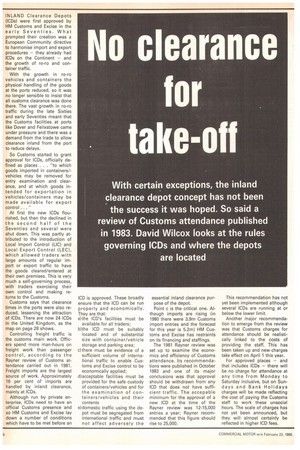No clearance for take-off
Page 28

If you've noticed an error in this article please click here to report it so we can fix it.
With certain exceptions, the inland clearance depot concept has not been the success it was hoped. So said a review of Customs attendance published in 1983. David Wilcox looks at the rules governing ICDs and where the depots are located
INLAND Clearance Depots (ICDs) were first approved by HM Customsand Excise in the early Seventies. What prompted their creation was a European Community directive to harmonise import and export procedures — they already had ICDs on the Continent — and the growth of ro-ro and container traffic.
With the growth in ro-ro vehicles and containers the physical handling of the goods at the ports reduced, so it was no longer sensible to insist that all customs clearance was done there. The vast growth in ro-ro traffic during the late Sixties and early Seventies meant that the Customs facilities at ports like Dover and Felixstowe came under pressure and there was a demand from the trade to allow clearance inland from the port to reduce delays.
So Customs started to grant approval for ICDs, officially defined as places . . . "to which goods imported in containers/vehicles may be removed for entry examination and clearance, and at which goods intended for exportation in vehicles/containers may be made available for export control ... "
At first the new ICDs flourished, but then the declined in the second half of the Seventies and several were shut down. This was partly attributed to the introduction of Local Import Control (LIC) and Local Export Control (LEC), which allowed traders with large amounts of regular import or export traffic to have the goods cleared/entered at their own premises. This is very much a self-governing process, with traders exercising their own control and making returns to the Customs.
Customs says that clearance times in the ports were also reduced, lessening the attraction of ICDs. There are now 24 ICDs in the United Kingdom, as the map on page 28 shows.
Controlling freight traffic is the customs main work. Officers spend more man-hours on freight work than passenger control, according to the Rayner review of Customs attendance carried out in 1981. Freight imports are the largest source of work. Approximately 16 per cent of imports are handled by inland clearance, mainly at ICDs.
Although run by private enterprise, ICDs need to have an official Customs presence and so HM Customs and Excise lay down a number of conditions which have to be met before an ICD is approved. These broadly ensure that the ICD can be run properly and economically. They are that: a)the ICD`s facilities must be available for all traders; b)the ICD must be suitably located and of substantial size with container/vehicle storage and parking area; c)there must be evidence of a sufficient volume of international traffic to enable Customs and Excise control to be economically applied; dlacceptable facilities must be provided for the safe custody of containers/vehicles and for the examination of containers/vehicles and their contents e)domestic traffic using the depot must be segregated from international traffic and must not affect adversely the essential inland clearance purpose of the depot.
Point c is the critical one. Although imports are rising fin 1980 there were 3.9m Customs import entries and the forecast for this year is 5.2m) HM Customs and Excise has restraints on its financing and staffings.
The 1981 Rayner review was set up to examine the economics and efficiency of Customs attendance. Its recommendations were published in October 1983 and one of its major conclusions was that approval should be withdrawn from any ICD that does not have sufficient traffic. The accepable minimum for the approval of a new ICD at the time of the Rayner review was 12-15,000 entries a year; Rayner recommended that this figure should rise to 25,000. This recommendation has not yet been implemented although several ICDs are running at or below the lower limit.
Another major recommendation to emerge from the review was that Customs charges for attendance should be realistically linked to the costs of providing the staff. This has been taken up and new charges take effect on April 1 this year.
For approved places — and that includes ICDs — there will be no charge for attendance at any time from Monday to Saturday inclusive, but on Sundays and Bank Holidays charges will be made reflecting the cost of paying the Customs staff to work these unsocial hours. The scale of charges has not yet been announced, but they will almost certainly be reflected in higher ICD fees.




















































































